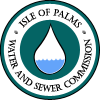Mission Statement
Our mission is to provide superior services and quality products in an efficient and productive manner through continuous improvement in organizational skills and assets, without negative environmental impact, and at the lowest possible cost.
Founding of the Commission
The Isle of Palms Water & Sewer Commission was formed July 1, 1992 by an ordinance enacted by the City of Isle of Palms and Section 5-31-250, et. seq., of the Code of Laws of South Carolina 1976. The Commission, as amended, is responsible for owning, operating, and managing the water and wastewater systems of the Isle of Palms but never to incur debt without the authorization and approval of the City. Since its inception, the Commission operated with three Commissioners until 1996, at which time the Isle of Palms City Council amended the number to five. These five Commissioners are elected by residents of the City of Isle of Palms, each serving six-year terms. The Commission operates solely on revenues generated by the sale of water and the treatment of wastewater, receiving no tax revenues. The system presently serves 4,624 accounts, this includes 3,767 residential, 123 commercial, 643 irrigation, 22 pool, 69 fire line, and 2,535 sewer accounts. Aside from the Commissioners, the Commission includes 12 staff members who work year-round to keep the Commission open, efficient, and operational.
The Commission’s water and sewer systems are municipally owned, providing services to the City of Isle of Palms. The Commission has an exclusive right to provide water and sewer services within the corporate limits of the City.
The South Carolina Department of Health and Environmental Control (DHEC) licenses the Commission to sell water & sewer services to residents and commercial properties within the Isle of Palms service area. DHEC periodically monitors the quality of water provided to our patrons and the Commission's treatment of wastewater. DHEC requires that the Commission provide monthly water quality and wastewater treatment reports for compliance with state and federal regulations.
Water Supply, Treatment and Distribution
Initially, water provided on the Isle of Palms was facilitated between two separate systems. The City of Isle of Palms purchased the first system from the Beach Company in 1991, just prior to the formation of the Commission in 1992. Years later the Commission purchased the second water system in Wild Dunes from Utilities Incorporated. For years the City's primary water resources were supplied by several shallow wells until two new wells, approximately 2,100 feet deep, were drilled. Both water systems were under DHEC consent orders to reduce fluoride content. In 1993, and in order to comply with the consent order, the Commission constructed a 1.2 million gallon per day (MGD) reverse osmosis water treatment plant. In 1997, the Commission constructed a 14-inch transmission line connecting the two independent systems, ending the consent order.
The water supply for the Isle of Palms includes an interconnection with Charleston CPW and two deep wells with a combined delivery capacity of approximately 3.0 MGD. The interconnect with Charleston CPW was accomplished by installing a 20” diameter transmission line from Fort Johnson, across the harbor, and across Sullivan’s Island terminating at Breach inlet. The average daily demand on the water system is 1.0 MGD with a peak demand of 2.5 MGD. The combined delivery capacity, in conjunction with our storage capacity of 2.4 MGD, provides the Commission with enough resources to meet our daily demand requirements and provide adequate storage to meet firefighting needs and ample water for 399 existing fire hydrants. The Commission currently operates and maintains 274,728 linear feet of distribution lines ranging in size from 2” in diameter to 16” in diameter.
Isle of Palms Wastewater Collection and Treatment
Wastewater on the Island is treated by our two separate treatment facilities. The Forest Trails Wastewater Treatment Plant, located at the corner of 41st Avenue and Waterway, has a treatment capacity of .3 MGD and discharges treated effluent into the Intracoastal Waterway. The Wild Dunes Wastewater Treatment Plant, located within Wild Dunes, has a treatment capacity of 1.07 MGD and discharges treated effluent to a lagoon where the effluent is used to irrigate portions of the Wild Dunes golf course.
Sewage is transported to these two facilities via 129,624 linear feet of gravity sewer lines ranging in size from 4” in diameter to 10” in diameter, with the assistance of 24 pump stations and 44,000 linear feet of force mains ranging in size from 4” in diameter to 8” in diameter.
Questions
Call (843) 886-6148.

